#1730's
Explore tagged Tumblr posts
Note
Hello! Transfem person here. I haven't started HRT yet, but want to procure a 1730s menswear suit (actually decided based on your video). I would prefer not to wait for it if possible, since I don't know when HRT is going to be possible. I am, however, a little concerned about my bust size changing and affecting the fit of the waistcoat. Is that decade usually pretty forgiving in it's tailoring? I am also considering having the upper back tie like some later waistcoats to accommodate if necessary (even if it's not entirely historical), but I figured I would ask you.
Thank you!
Hello! Ooh yay! Not enough people do early 18th century, so I'm delighted to hear that! (Link to the 1730's suit mentioned.)
I think the fit would be affected, yeah. The sides of the waistcoat are easy enough to let out (and we have extant examples of waistcoats with an extra strip of fabric added into the side seam) but the curve of the front is pretty important to how it sits on you. But then, it is fashionable in that era to leave quite a lot of the top portion unbuttoned, so maaaybe you could get away with it not fitting as well, depending on what changed and how much?
Regarding the adjustability of waistcoats, some of the earlier ones actually do have lacing in the back! This red one is an especially nice example, and it's separate all the way to the top.
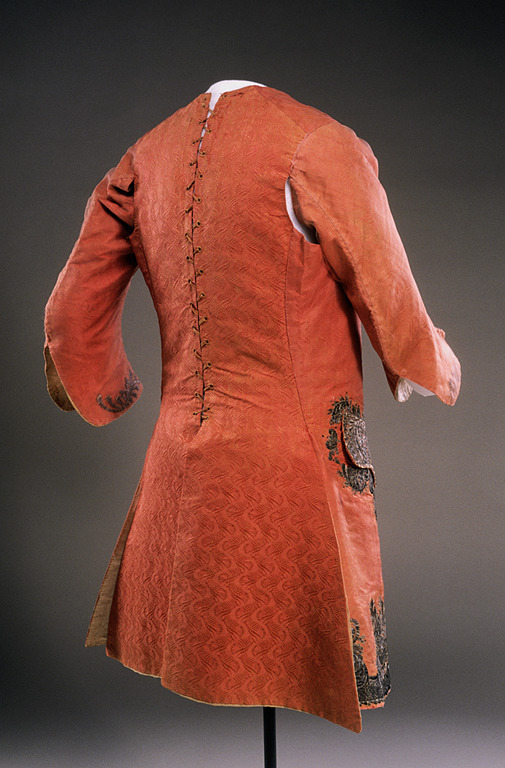

(c. 1740's, V&A) (Though you also do see ones with the back hacked up and a bunch of ties that were likely added by Victorians for their fancy dress parties.)
The breeches also have adjustable waistbands, of course, so I think the hardest part to alter would be the coat. The back vent is edge to edge, so there's no overlap to sneak a bit more width out of, and letting out the side seams would require re-doing those massive pleats, which were the part I found the most difficult when making my coat. But fortunately those coats were worn open a lot of the time, so even if they're not quite right when buttoned, they should still look ok unbuttoned.
It's very difficult to predict how the fit will be affected, since HRT is different for everyone and things keep changing years down the line. (One comment on this post talks about suddenly getting more breast and hip growth after 7, 12, and 14 years.)
I only have experience from the transmasc side of things, and alas, I very much did outgrow all my old waistcoats and coats. My 1730's suit needs alterations, because the waistcoat is a bit too small, and the coat seams could use a bit of letting out too. (I made those the year after top surgery, but my ribcage kept expanding and my posture improving for quite a while.)
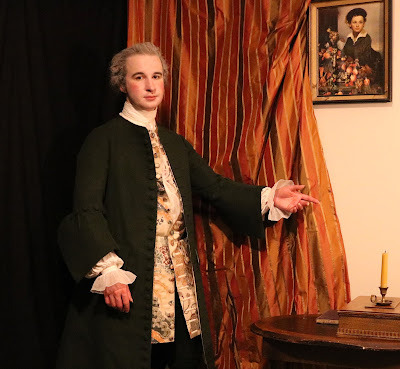
I've been putting it off because alterations are boring :/ My pre-top surgery waistcoats are all way too small across the chest even though material was removed, because my posture was kinda bad and I didn't even notice it, and I expect that the opposite could also lead to the same sort of better posture from more confidence & comfort.
But bodies keep changing forever anyways, even without transitioning. Plenty of cis people can't fit into the things they sewed when they were younger, so we may as well make things to fit us now. Perhaps you could make the suit now, but use a not-too-expensive fabric, and then maybe alter it later, or make a newer and better one with the experience you gained from the first one!
Also I know you specifically said menswear suit, but I want to add the fun fact that women's riding habits in this era looked extremely similar to men's suits!


(Left: Maria Amalia von Habsburg by Franz Joseph Winter, right: Member of the Van der Mersch Family by Cornelis Troost.)
As far as I can tell, the main differences are that the riding habits have a petticoat instead of breeches, and are made to fit over stays.
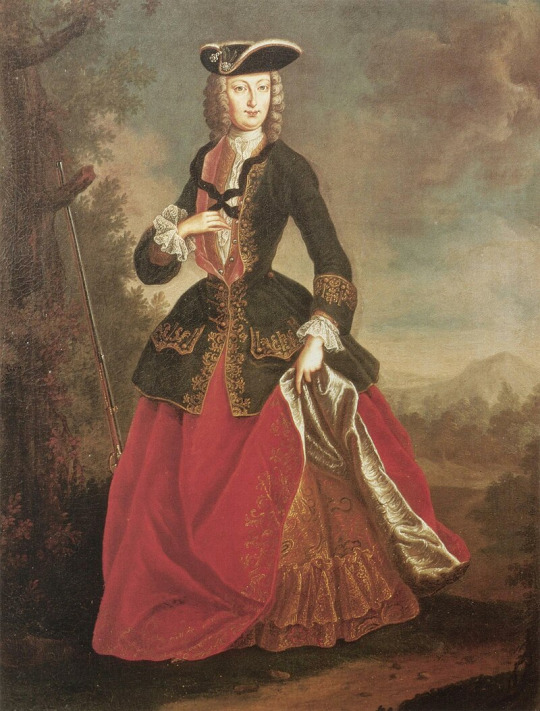
(Empress Elisabeth Christine in riding costume, unknown artist.)
So similar, in fact, that this portrait of a young lady in a riding habit was misidentified as a young man!
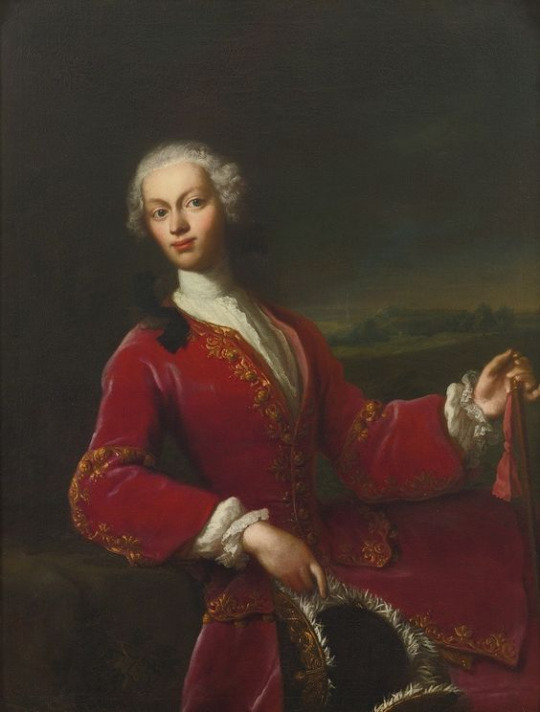
Most of the petticoat is out of frame, but you can still see that it's not beeches, and the stays shape is pretty obvious. Very silly of Sotheby's not to notice!
I have no idea if you're interested in wearing a riding habit, and I'm not sure how difficult it would be to alter the somewhat looser men's coat to fit over stays, but thought I ought to mention it.
236 notes
·
View notes
Text
I just feel like Astarion is the epitome of the Rococo period.
#it’s so late and I’m so tired#I keep thinking about how Astarion would lose his goddamn mind in 1730’s Paris#bg3#astarion#snowyrambles
15 notes
·
View notes
Text
take her under your wing 101
an intro to the au



here is a comprehensive little breakdown of this AU and its main characters.
au masterlist | pinterest board
masterlist | join my taglist

THE CHARACTERS:
KAPPA ALPHA NU FRATERNITY
THUYW!READER & DELTA PHI SORORITY
GAMMA SIGMA ZETA FRATERNITY
HIGHRIDGE UNIVERSITY FACULTY MEMBERS

RANDOM HIGHRIDGE UNIVERSITY FACTS:
the school mascot is a hawk
it was founded back in 1730
there is a legendary rivalry between the Kappa Alpha Nu fraternity and the Gamma Sigma Zeta fraternity. it began back in the 60's and though no one today really remembers what happened to spark it, many scandalous theories have popped up throughout the years.

© 2025 thyme-in-a-bubble
#lea’s writing#take her under your wing au#stucky x reader#bucky barnes x reader#steve rogers x reader#peter parker x reader#ari levinson x reader#lloyd hansen x reader#andy barber x reader#stepbro!steve rogers#ransom drysdale x reader#marc spector x reader#thor odinson x reader#scott lang x reader#miguel o'hara x reader#billy russo x reader#bucky barnes smut#steve rogers smut#curtis everett x reader#frank castle x reader
352 notes
·
View notes
Text
Early 18th (and late 17th) century fashions are so under-utilized in vampire media and I think it's a damn shame.
I don't actually think I've ever seen a single image of a vampire character in an early 18th century suit. Hardly any movies set in that era either, and hardly any historical costumers who do it. (Even my beloved gay pirate show set in 1717 takes nearly all of its 18th century looks from the second half of the century. Not enough appreciation for baroque fashion!!)
Yes I love late 18th century fashion as much as anyone, and 19th century formal suits are all very well and good, but if you want something that says old, dead, wealthy, and slightly dishevelled, then the 1690's-1730's are where it's at.
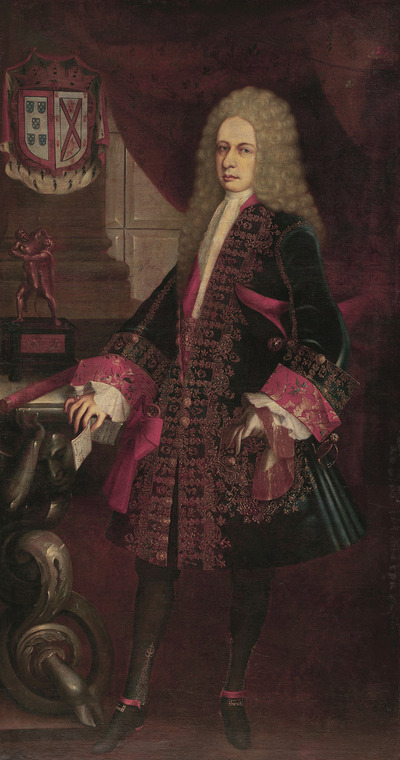
(Retrato del Virrey Alencastre Noroña y Silva, Duque de Linares, ca. 1711-1723.)
There was so much dark velvet, and so many little metallic buttons & buttonholes. Blood red linings were VERY fashionable in this era, no matter what the colour of the rest of the suit was.
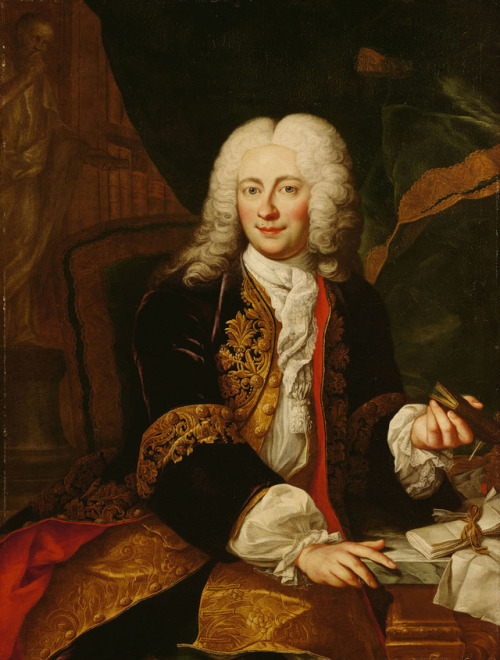
(Johann Christoph Freiherr von Bartenstein by Martin van Meytens the Younger, 1730's.)
The slits on the front of the shirts are super low, they button only at the collar, and it's fashionable to leave most of the waistcoat unbuttoned so the shirt sticks out, as seen in the above portraits.
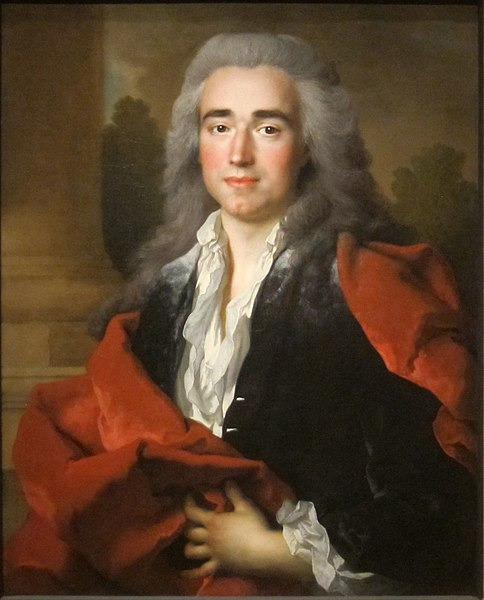
(Portrait of Anne Louis Goislard de Montsabert, Comte de Richbourg-le-Toureil, 1734.)
Waistcoats are very long, coats are very full, and the cuffs are huge. But the sleeves are on the shorter side to show off more of that shirt, and the ruffles if it has them! Creepy undead hands with long nails would sit so nicely under those ruffles.
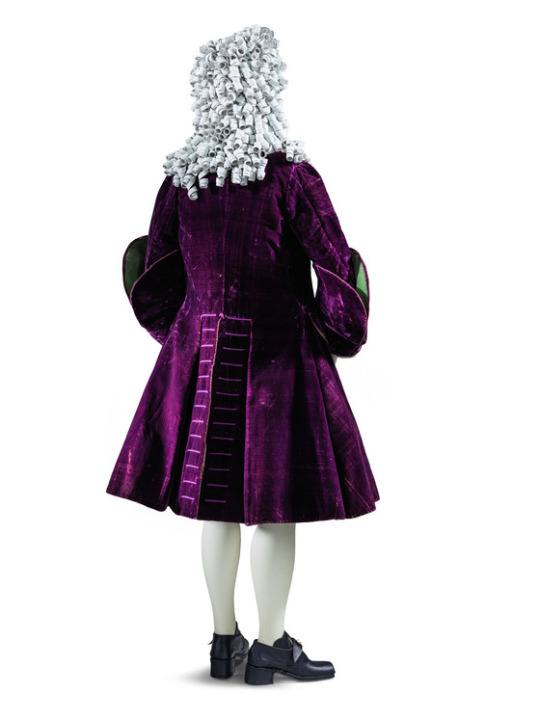
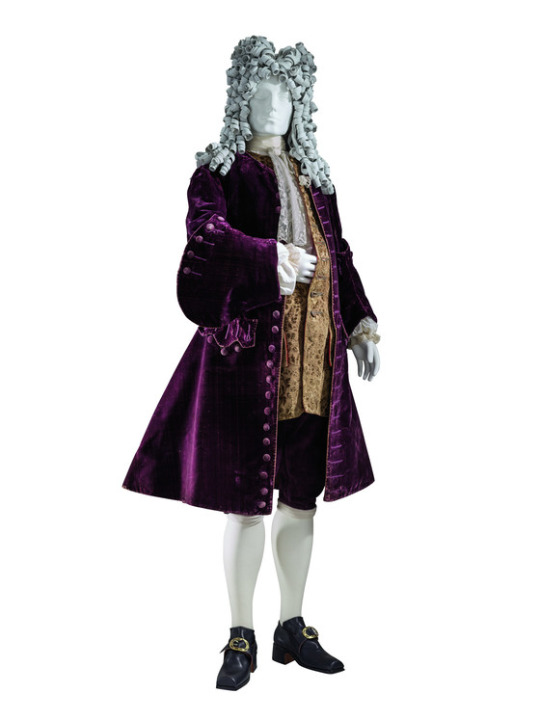
(1720's-30's, LACMA)
Embroidery designs are huge and chunky and often full of metallic threads, and the brocade designs even bigger.
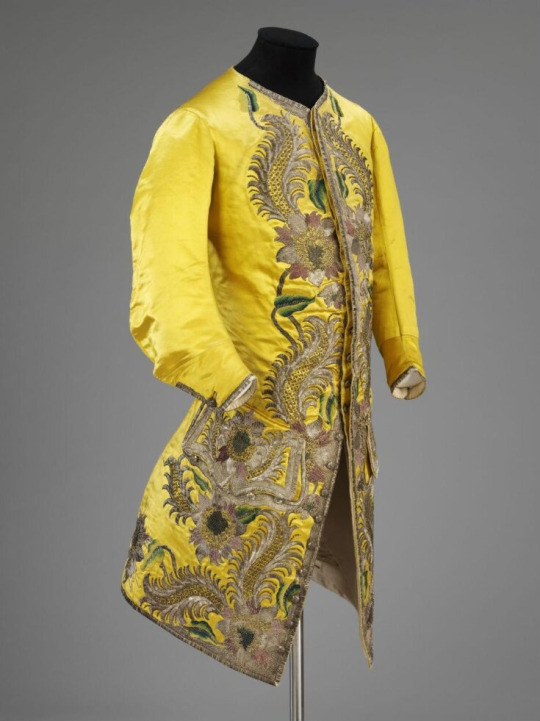
(1730's, V&A, metal and silk embroidery on silk satin.)
Sometimes they did this fun thing where the coat would have contrasting cuffs made from the same fabric as the waistcoat.
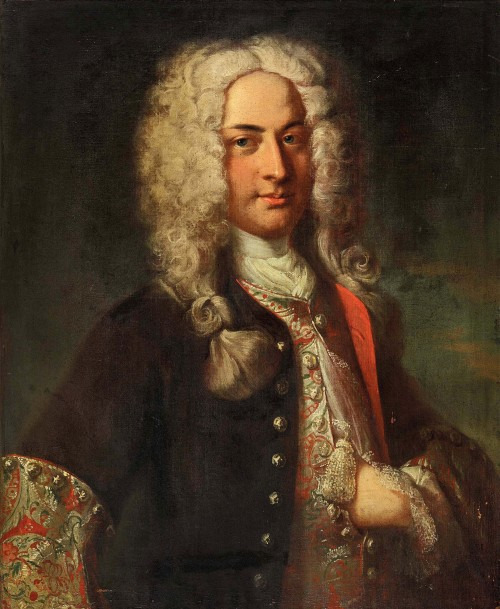
(Niklaus Sigmund Steiger by Johann Rudolf Huber, 1724.)
Tell me this look isn't positively made for vampires!
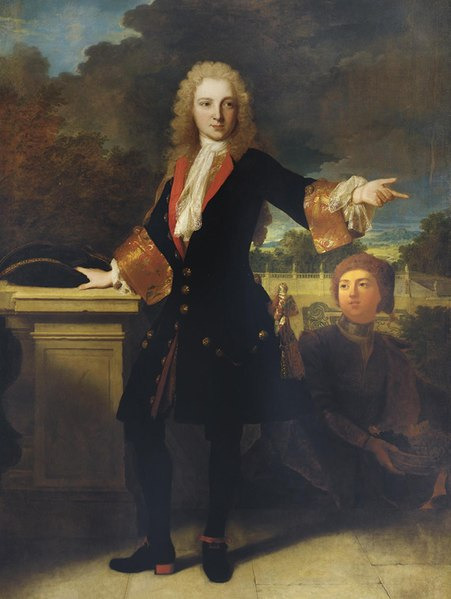
(Portrait of Jean-Baptiste de Roll-Montpellier, 1713.)
(Yeah I am cherry-picking mostly red and black examples for this post, and there are plenty of non-vampire-y looking images from this time, but you get the idea!)
And the wrappers (at-home robes) were also cut very large, and, if you could afford it, made with incredible brocades.
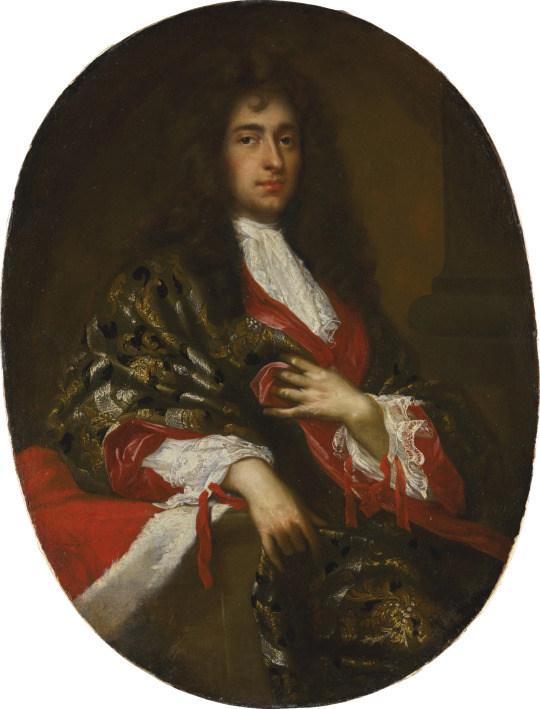
(Portrait of a nobleman by Giovanni Maria delle Piane, no date given but I'd guess maybe 1680's or 90's.)
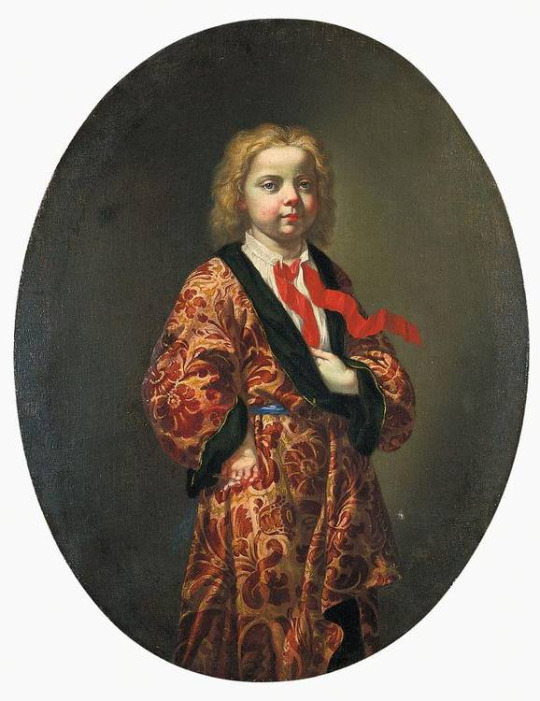
(Circle of Giovanni Maria delle Piane, no date given but I'd guess very late 17th or very early 18th century.)
Now that looks like a child who's been stuck at the same age for a hundred years if I ever saw one!
I don't know as much about the women's fashion from this era, but they had many equally large and elabourate things.
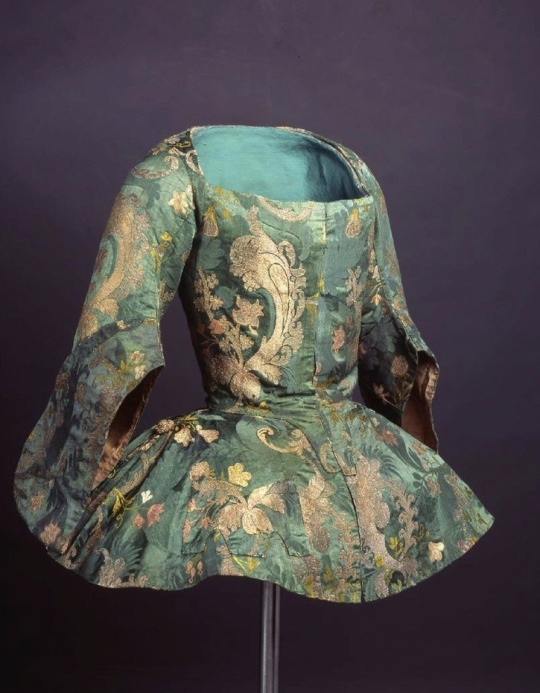
(1730's, Museo del Traje.)
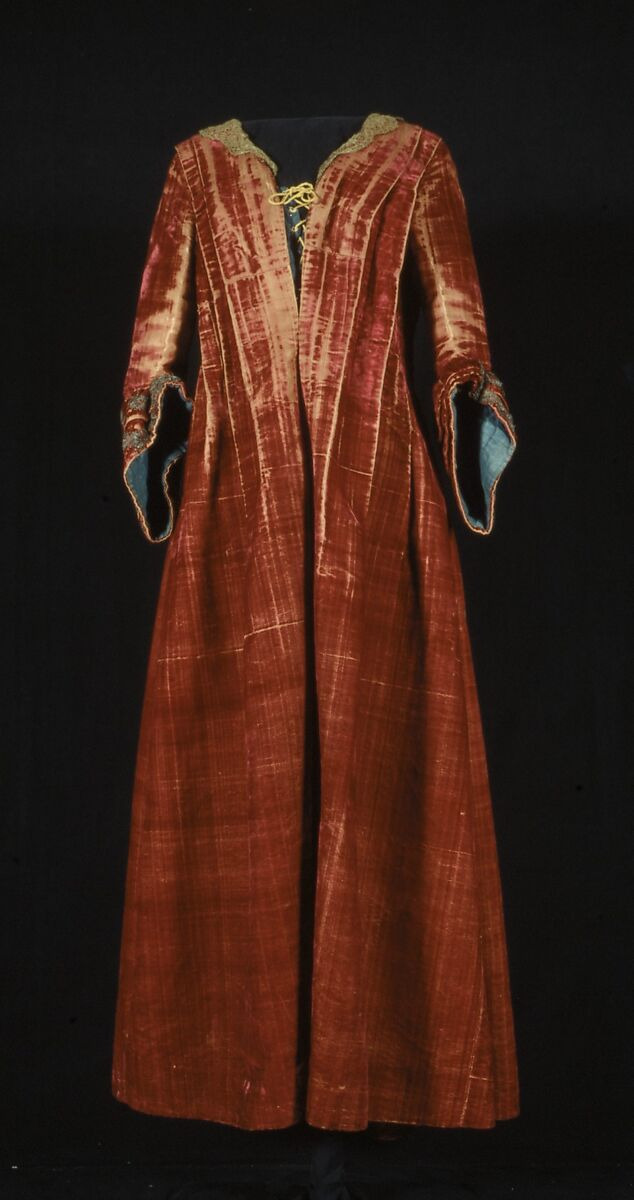
(Don't believe The Met's shitty dating, this is a robe volante from probably the 1720's.)
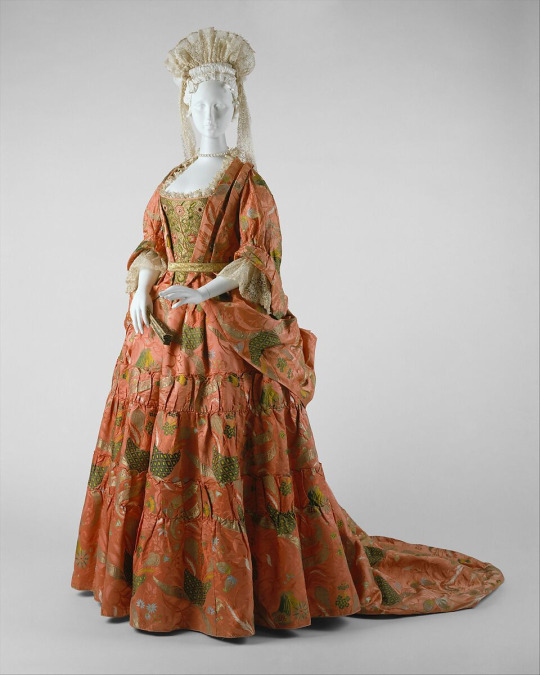
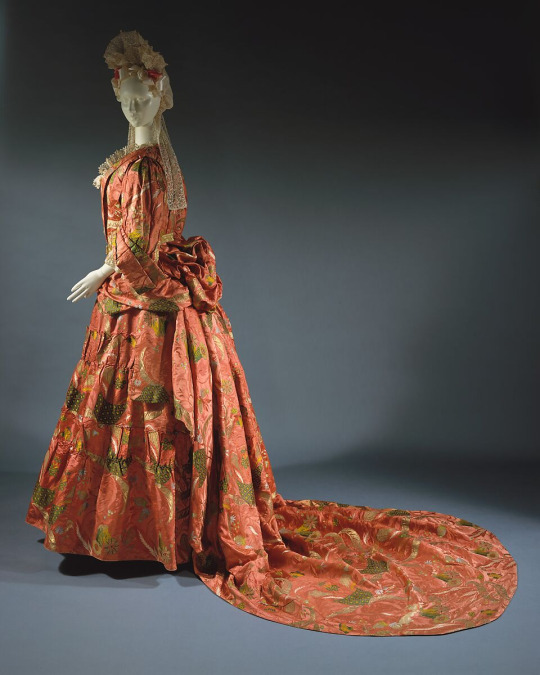
(Mantua, c. 1708, The Met. No idea why they had to be that specific when they get other things wrong by entire decades but ok.)
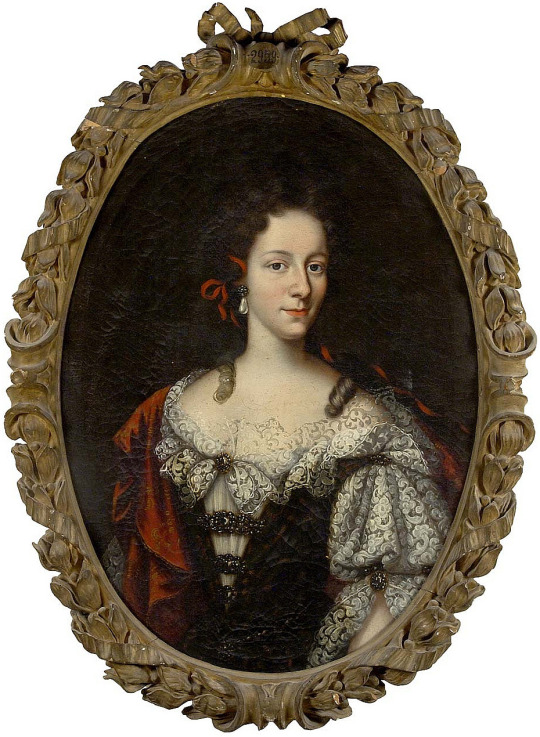
(Portrait of Duchess Colavit Piccolomini, 1690's.)
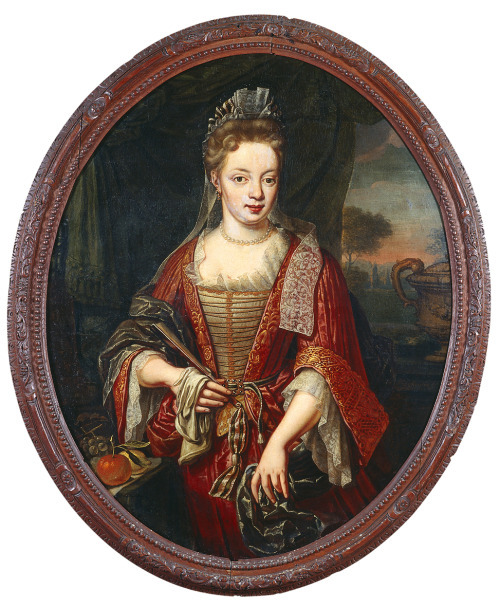
(Maria van Buttinga-van Berghuys by Hermannus Collenius, 1717.)
Sometimes they also had these cute little devil horn hair curls that came down on either side of the forehead.
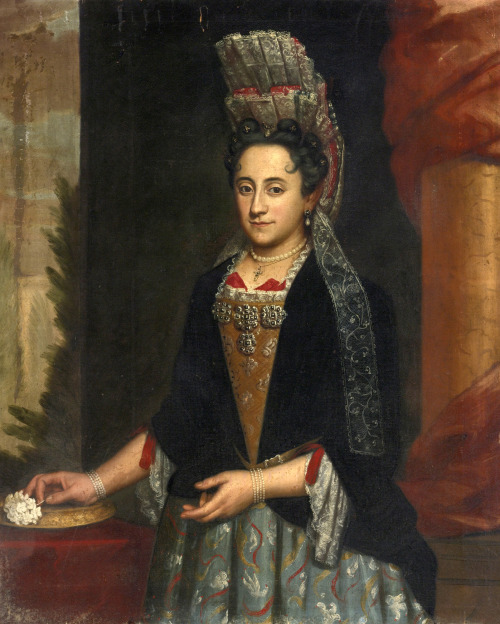
(Viago in drag Portrait of a lady, Italian School, c. 1690.)
Enough suave Victorian vampires, I want to see Baroque ones! With huge wigs and brocade coat cuffs so big they go past the elbow!
#long post#vampires#fashion#history#18th century#17th century#someday. SOMEDAY I will make a black/red/dark orange/metallic gold 1720's suit#I've got nearly all the materials I just need to:#1. Learn how to make early 18th century metallic thread buttons‚ preferably without having to buy the super expensive kind of thread#2. get a wig and style it appropriately
3K notes
·
View notes
Text
More highlights of notes about the brothers Grimm fairytales!
I continue my list of which fairytales were deleted to become which story. The German "Puss in Boots" was removed in favor of "The three languages". "Trine, Hans' woman" was replaced by "Clever Elsa". "The Sparrow and its four children" was removed in favor of "The Tailor in Heaven". Technically speaking, "Tom Thumb" replaced "The bag, the hat and the horn" - though it wasn't removed, just displaced in the order. "Frau Trude" replaced "The strange feast" - even though interestingly, these two stories have been identified as examples of the two "forms" of the farytale-type AT 334, "The witch's household". The Strange Feast is the 334 B, typical of Western Europe ; Frau Trude is the 334 A, typical of Eastern Europe.
The first version of "The Wedding of Frau Fox" was noted to be one of Jacob Grimm's favorite fairytales. It came from his childhood and he was very fond of it. Though the Grimms had to "censor" the fairytale because Achim von Arnim saw in there sexual subtext showing this story was infected by *cough cough* "French debauchery" (Zeiselschwänze - Zieselschwanz).
There is a true "Bluebeard cycle" in the Grimm fairytales: The Robber Bridegroom, Fitcher's Bird, and deleted fairytales such as the Grimm Bluebeard or the Murder Castle.
The reason why poor Herr Korbes gets massacred by the animals is, according to the Grimms, because he is some sort of bogeyman. H-J. Uther identifies it as part of a cycle of "spook tales" alongside "Der Herr Gevatter" (Herr Godfather) and "Frau Trude".
A variation of "Fitcher's Bird" is about a poor woodcutter asking his daughters to bring him his meal while he works in the forest - he uses peas to mark the way, but dwarves that live in the forest change the peas so that the girls travel to their house instead. The girls are enslaved, with the forbidden room motif. In this version the last daughter disguises herself as a bird by rolling in the blood of the forbidden chamber before covering herself in feathers, and those she meet in the forest are talking foxes asking where this "geputzter Vogel" is going. The dwarves hunt the girl down and she manages just in time to return to her father's house - but she cuts off a piece of her heel due to slamming the door so fast. And yeah, here the older sisters stay dead.
While "Briar Rose" clearly takes after Perrault's "Sleeping Beauty", it also bears the mark of madame d'Aulnoy's "The Hind in the woods" (originally it was a crayfish who announced to the queen her pregnancy, just like in d'Aulnoy's story - the Grimms later changed it to a frog). However the name of Briar Rose, "Dornröschen", "Little thorn rose", comes from a German translation of 1730's "Thornflower Story" by Irish-French Anthony Hamilton.
The Grimms themselves made a link between their Briar Rose and their Snow White (alongside the Brunhild legend, and the Pentamerone Thalia, the Sun and the Moon). They also were VERY careful in removing all mentions of "fairies" or "Fee" from their stories to distantiate their Germanic stories from the French "fairy tales", "contes de fées" - hence why here you have "wise-women".
Rapunzel was directly taken out of the German translation (by Friedrich Schulz) of mademoiselle de La Force's French literary fairytales "Persinette". Of course this is a well-known trivia, but the Grimms edited the text over their publications to censor the sexual content of the original draft - Rapunzel doesn't fall pregnant anymore, and the prince now promises to marry her upon seeing her, instead of the two of them living in the debauchery of sinners X)
There's variations of the Rapunzel story where it is not always the mother who wants something out of the witch - sometimes it is the father who craves something. And the witch sometimes asks the father for his future child with the ambiguous saying "I want what's under you belt" (a sentence probably too saucy for the Grimms). To explain Frau Gothel's name, the brothers Grimm tried to explain it as such: the godfather could be called "Vater" (father) or Pathe (godfather) indifferently, as well as "Goth" or "Dod", but the baptized child could also be called "Pathe" or "Gothel", resulting in a confusion of the two figures". So, for the Grimms, Gothel still means "Godmother" but is still treated as a proper name, hence "Frau Gothel".
In a variation the Grimms had of Little Brother and Little Sister, the brother was turned into a doe by the stepmother herself, who then released her hunting dogs after him - while the sister was thrown out of the window by the witch and turned into a female duck.
Ludwig Emil Grimm illustrated Little Brother and Little Sister by showing an angel holding its hands over the children - despite no angel actually appearing in the text. This led to the popular misconception, or belief, that the children had a guardian angel. The brothers Grimm also linked this fairytale, and the one of "The Three Little Men in the Woods", with the French legend of Mélusine (as in the mother goes back to feed and care for her children).
#brothers grimm#grimm fairytales#little brother and little sister#fitcher's bird#briar rose#rapunzel
29 notes
·
View notes
Text

Grove Shaft Ventilation Building Ruins (II)
Mid-Lothian Mines Park
Chesterfield County, Virginia (USA)
Based on a photo from May 10, 2025.
Side view of the Grove Shaft building ruins. Coal was discovered west of Richmond by French Huguenot settlers who collected it by the James River for domestic purposes. By the 1730's, commercial coal mining within the Richmond Coal Basin developed. In the 1830's, the Mid-Lothian Mining Company who owned the Grove Shaft and 3 others in the Midlothian area began their operations.
24 notes
·
View notes
Text
Missed Details from Sukuna's Introduction
Did you guys know that there are details we've missed from Sukuna's introduction by Satoru Gojo in chapter 3?

JJK Chapter 3
In this post, I'll go over the few details we've missed because of translation issues or difficulties.
WARNING: Very minor mentions of details beyond season 2 of JJK anime. Please DO NOT INTERACT if you don't want even a tiny bit of spoiler. Also, a bit of a long post ahead.

Missed Detail #1:
Let's start with this panel first.

"Ryomen Sukuna is an imaginary fierce god who has 2 faces and 4 arms."
In this panel, Sukuna was called a 鬼神 (kishin), which in general means a 'fierce god or spirit'. But there are also other meanings beyond this.
鬼神 also refers to gods or spirits/souls of heaven and earth. It is also a Buddhist term that refer to beings with supernatural abilities (e.g. shinigami, rakshasa). 鬼神 can also be pronounced as onigami, which means an invisible (nature) spirit, or a fierce and frightening god or spirit.
So this reflects the belief of people that Sukuna is a fiercely frightening divine being. They might've also believed that he was there even if they couldn't see him, just like how we treat our God(s) in real life (if you're a believer). They are definitely aware of his frightening powers.
It also has another implication behind it. The first kanji, 鬼, means oni. Oni has many translations including demon, evil spirits, trolls and ogres. In addition, during Heian era, the oni creatures were depicted as terrifying monsters that ate people, and there are even literature where oni's were depicted eating people in one mouthful.

Blue Oni, c. 1764. Painting by Soga Shōhaku (1730–1781)
The word 鬼神 is ironic, as well, because of his outward appearance, he can be considered an oni and a divine one at that.

Missed Detail #2:
Below is our last analysis for this post.

"Crowned with the title (name) of Sukuna, we couldn't even eradicate his grave wax that traverse eras as cursed objects."
The title that people gave to this man is 'Sukuna' alone. I don't know why they included 'Ryomen' in the English translation.

JJK Chapter 3 (ENG Translation)
I repeat. The only title they gave this man was 'Sukuna' (宿儺), which means the 'dwelling of exorcism.' 宿 (Suku) means lodging, inn, home, dwellings; while 儺 (Na) means exorcism or the ceremony of driving out evil spirits. What a great name for this guy!
Then what about Ryomen? Where did that come from?
I believe this is the name that they've been calling him for almost his entire life, even before he was called 'King of Curses'. That's right. This is definitely the name - means 'two-faced', btw - that they call him as a kid and became stuck with him until now. Imagine being called 'two-faced' as you grow up. That's most likely Sukuna's life until he was given the title of 'Sukuna'.
His name is ironic in a sense since these people equated him to the (real-life) Ryomen Sukuna who was written in the Nihon Shiki as a vicious force of nature after the imperial family of Japan declared him as such.

So yeah there you have it. Thank you, Gojo, for the wonderful introduction of Sukuna.
I hope this post made your day. Until then.


References:
https://en.wikipedia.org/wiki/Oni
https://en.wiktionary.org/wiki/%E9%AC%BC%E7%A5%9E
https://ja.wikipedia.org/wiki/%E9%AC%BC%E7%A5%9E
#jjk#jujutsu kaisen manga#jujutsu kaisen#sukuna#sukuna ryomen#ryomen sukuna#jjk sukuna#sukuna analysis#jjk manga#jjk meta#jjk analysis#jjk spoilers#jjk gojo#gojo satoru#jujutsu sukuna#uncle sukuna#sukuna x reader#jjk 266
127 notes
·
View notes
Text
✦ Rococo Hairstyles ✦





✦ 1730s-1790s ✦
1 - By Javi Trulove.
2 - By Historicalsimslife.
3 - By Melancholy Maiden.
4 - By Acanthus Sims.
5 - By ?
6 - By ELFDOR.
7 - By Javi Trulove.
8 - By Inlovewithregencyera.
9 - By Buzzardly28.
10 - By Historicalsimslife.
11 - By Inlovewithregencyera.
12 - By Inlovewithregencyera.
13 - By Melancholy Maiden.
14 - By Aarainaroma.
15 - By Historicalsimslife.
16 - By HistoryLover'sSimblr.
17 - By Inlovewithregencyera.
18 - By Javi Trulove.
19 - By Inlovewithregencyera.
20 - By Historicalsimslife.
21 - By Theregalsim.
22 - By Theregalsim.
23 - By Acanthus Sims.
24 - By Theregalsim.
25 - By Acanthus Sims.
26 - By Acanthus Sims.
27 - By Theregalsim.
28 - By Acanthus Sims.
29 - By Historicalsimslife.
30 - By S-Club.
Thanks to the creators ♡︎
#the sims 4#sims4 cc#ts4 cc#sims 4 decades#ultimate decades challenge#sims 4 hair#sims 4 custom content#1730s#rococo#hairstyles
21 notes
·
View notes
Text
A stunning view for #SackBackSaturday from Historic Deerfield— check out the pattern matching across the deep pleats, floss fringe & sumptuous brocaded silk; textile c. 1730-40; garment made, 1760-70. Maker and wearer unknown. For more gorgeous images & information, see http://museums.fivecolleges.edu/detail.php?museum=hd&t=objects&type=all&f=&s=Gown&record=126
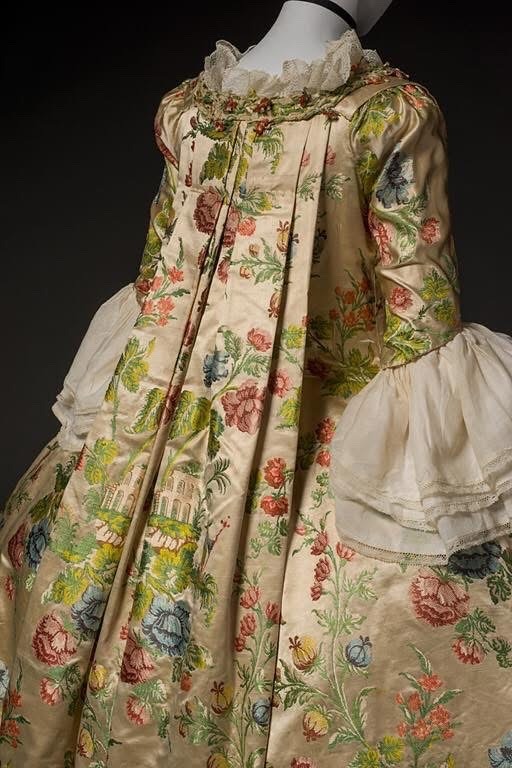
28 notes
·
View notes
Text

Don Quixote Addressing the Goatherds
Artist: John Vanderbank (English, 1694–1739)
Date: 1730
Medium: Oil paint on canvas
Collection: TATE Britain
Description
The panel is one of nearly forty similar scenes from 'Don Quixote' which Vanderbank painted during the 1730s. They are related to but not direct replicas of the more than sixty illustrations, begun in 1723, which the artist drew for an edition of Cervantes's novel published by Tonson in 1738.
Don Quixote, the full title being The Ingenious Gentleman Don Quixote of La Mancha, s a Spanish novel by Miguel de Cervantes. It was originally published in two parts, in 1605 and 1615. Considered a founding work of Western literature, it is often said to be the first modern novel. The novel has been labelled by many well-known authors as the "best book of all time" and the "best and most central work in world literature". Don Quixote is also one of the most-translated books in the world and one of the best-selling novels of all time.
For Cervantes and the readers of his day, Don Quixote was a one-volume book published in 1605, divided internally into four parts, not the first part of a two-part set. The mention in the 1605 book of further adventures yet to be told was totally conventional, did not indicate any authorial plans for a continuation, and was not taken seriously by the book's first readers.
#painting#literary scene#oil on canvas#landscape#men#don quixote de la mancha#spanish novel#spanish literature#miguel de cervantes#western literature#fine art#oil painting#hut#trees#foliage#costume#cloudy horizon#spanish culture#john vanderbank#english painter#european art#artwork#18th century painting#tate britain
23 notes
·
View notes
Note
I again don't know what you're yappin' 'bout.
Which proves my point that you're in fact brainrotted, hahaha!
uh hey someone that looks like you just somehow knows i competed in some things..
i'm getting the creeps from this not-so mario
-💧
Ya mean Cleaver guy? Oh yeah he seems a bit "brainrotted" like the youngsters say with ya' show.
I don't know what i can do to help ya', so stay strong i guess?
#“kids these days....” -horror mario /j#<- horror mario i show him skibidi toilet 70 instead of jimmy warnwarning from the 1730's that has one chapter and is lost media except+#for one clip that can only be accessed by factory resetting your phone and saying the series name three times/j
16 notes
·
View notes
Note
Congrats on the moving to somewhere with space for your Big Table!! I know the kind of joy and ease that can bring to creative projects. There's a line in The Time Traveller's Wife about a character making small art in her small space and having the freedom to make big art once they move to a bigger house so I hope that you feel excited and I can't wait to see whatever you choose to make 🌼
Thank you!! I am 29 years old and have never in my life had a proper sewing room, so I'm very excited! It'll be so much easier to work on stuff, and I'll be able to film videos without moving furniture.
#the amount of crap I had to move in order to get the corner empty for that 1730's getting dressed video was ridiculous...#and even then I couldn't get the camera far enough away to get all of me in the shot standing up#ask
115 notes
·
View notes
Text
it's possible I made an extended playlist to give context to the classical (non-technically speaking) music in OFMD, with the pieces listed in historical/chronological order, and in the context of their full pieces (mostly - I'm not literally going to put entire operas on there, but symphonies and concertos have mostly been finished)
and it's possible that that playlist is ten hours long
and it's possible you can find it on spotify right now, and that below the cut is the full chronology
(edit: corrections welcome btw!!!! i am by no means a music historian, nor have any higher level music education, just a lifelong association and interest <3 if you know better than me, PLEASE let me know so it can be more accurate!)
N: most of the Vivaldi pieces don't really have any dates I could find, so they're just sort of scattered through the first few decades of the 18th century. and yes, technically the opening Corelli isn't in there, but I think putting another La Folia in is important for the context of s2!
1700 - Arcangelo Corelli, Violin Sonata in D Minor, Op 5 No 12 "La Follia"
1703-6 - George Frederic Handel, Keyboard Suite No 4 in D Minor, HWV 437
? - Antonio Vivaldi, Cello Concerto in G Minor, RV 416
1711 - Antonio Vivaldi, Concerto No 11 in D Minor for Two Violins and Cello RV 565
1715 - Georg Philipp Telemann, Sonata for Violin and Basso Continuo in G Major TWV 41:G1
1718-20 - Antonio Vivaldi, The Four Seasons, Violin Concerto in G Minor Op 8
Early/mid C18 - Domenico Scarlatti, Keyboard Sonata in F Major, K 107
? - Antonio Vivaldi, Oboe Concerto in C, RV 452
1720s? - Antonio Vivaldi, Concerto for Two Cellos in G Minor, RV 531
1727 - Johann Sebastian Bach, Ich steh mit einem Fuß im Grabe, BWV 156
1725-35 - Georg Philipp Telemann, Concerto for Recorder and Viola da Gamba in A Minor TWV 52:a1
? - Antonio Vivaldi, Concerto in G Minor, RV 576
1730 - Johann Sebastian Bach, Orchestral Suite No 3 in D Major, BWV 1068
? - Antonio Vivaldi, Piccolo Concerto in A Minor, RV 445
? - Antonio Vivaldi, Trio Sonata in D Minor, RV 63, 'La Follia'
1738 - Johann Sebastian Bach, Harpsichord Concerto No 4 in A Major, BWV 1055
1738-9 - Johann Sebastian Bach, Concerto for Harpsichord, Strings, and Continuo No. 5 in F Minor, BWV 1056
Early/mid C18 - Domenico Scarlatti, Keyboard Sonata in E Major, K 380
1741 - Johann Sebastian Bach, Goldberg Variations, BWV 988
1747 - Johann Sebastian Bach, Musical Offering, BWV 1079
1747-8 - George Frederic Handel, Concerto in F Major, No 16, HWV 305a
1773 - Mozart, Symphony No 25 in G Minor, K 183
1782 - Mozart, String Quartet No 14 in G Major, K 387
1795 - Beethoven, Piano Sonata No 2 in A Major, Op 2 No 2
1792 - Beethoven, Piano Sonata No 3 in C Major, Op 2 No 3
1780 - Mozart, Symphony No 34 in C Major, K 338
1786 - Mozart, Le nozze di Figaro (excerpts)
1810? - Beethoven, Bagatelle in A Minor, WoO 59: Für Elise
1811-12 - Beethoven, Symphony No 7 in A Major, Op 92
1826 - Franz Schubert, Ständchen (Serenade) "Horch, horch, die Lerch!" D 889
1827 - Franz Schubert, 4 Impromptus, Op 90, D 899
1833-4 - Felix Mendelssohn, Lieder Ohne Worte, Book 2, Op 30
1835 - Frédéric Chopin, 12 Études, Op 25 (excerpts)
1838 - Robert Schumann, Kinderszenen, Op 15 (excerpts)
1838 - Franz Liszt, arr., 12 Lieder von Franz Schubert, S 558, No 9
1842 - Frédéric Chopin, Waltz No 12 in F Minor, Op 70, No 2
1871 - August Wilhelmj, arr., Air on a G String
1874 - Giuseppi Verdi, Messa da Requiem (excerpts)
1878 - Antonín Dvořák, String Sextet in A Major Op 48
1888-91 - Claude Debussy, Two Arabesques, L 66
1890 - Claude Debussy, Rêverie, L 68
1888, 89, 90 - Erik Satie, Trois Gymnopédies, Gnossienne No 5, Trois Gnossiennes
#OFMD soundtrack project#Our Flag Means Death#OFMD#OFMD music#Our Flag Means Death music#OFMD soundtrack#Our Flag Means Death soundtrack#music
56 notes
·
View notes
Text
Is there an 18th century manuscript in your pocket, or are you just happy to see me? This is the question that opens chapter II of The Hound of the Baskervilles, this week's Letters from Watson.
I have been distracted by the long-s, which appears in manuscripts from the 17th through early 19th century. If Mortimer's manuscript was printed, there are numerous rules that apply to use of long and short s. But surely it's handwritten? In that case, the long-s would appear only in double-s combinations. There are 16 such in the manuscript. I resisted the urge to try formatting the text to see if any of them would appear near a fold, peeking out of a pocket.
Since there's a period of more than a century when long-s is commonly used, Holmes must also be drawing conclusions from the paper, or the shade of the ink, or the style of the handwriting (or printing?).
“You have presented an inch or two of it to my examination all the time that you have been talking. It would be a poor expert who could not give the date of a document within a decade or so. You may possibly have read my little monograph upon the subject. I put that at 1730.” “The exact date is 1742.” Dr. Mortimer drew it from his breast-pocket.
That "or so" in Holmes' boast is doing a lot of work.
Since the document refers to Lord Clarendon's work, which is The History of the Rebellion and Civil Wars in England (written 1646-8, published 1702-4), the Great Rebellion must be the conflict between royalists and Parliamentarians that led to the execution of King Charles I, the Commonwealth under Oliver Cromwell, and eventually to the UK becoming a constitutional monarchy.
"Godless" Hugo Baskerville sounds like standard demonization of the royalists as debauched and corrupt. However, since Baskervilles apparently held their land consistently through the entire period, they may also have been good at either playing with whatever side was winning or keeping their heads down.
Hugo is neither a nice nor a good man, so there's a certain glee in his being struck down by a slavering hell hound.
In contrast, Sir Charles Baskerville possesses "amiability of character and extreme generosity." His fortune made in South Africa was, nonetheless, derived from exploiting native peoples -- unless he was running a sugar cane plantation in Natal, in which case he likely shipped in indentured servants from India to exploit as workers. (I'm being terse because British colonialism in Africa was an endless pit of awful -- and also heavily romanticized in literature -- and I'm on the verge of ranting into topics where I may have details blurry. The Guardian has a piece.)
The two ethnic groups Mortimer and Baskerville discussed as "comparative anatomy" would today be San, foraging people who rejected British efforts to turn them into farmers and who... oh bloody hell, were deliberately hunted with approval of the government. The other is the pastoral Khoekhoe, who raised sheep and cattle. Did the British colonies try to enslave the Khoekhoe as labor? Of course they did.
By the standards of the day, Sir Charles Baskerville was not a prime candidate to be haunted by his conscience, nor by hell hounds, though.
I'm not even touching Murphy the traveler, whose testimony is suspect due to drink. Argh.
Surely Sir Charles' tip-toe stride was running? But what of his facial contortions? I feel immediate distrust for Mr. Stapleton, based on nothing but James Mortimer's liking him.
The list of people I wouldn't mind seeing eaten by a hell hound is growing. How long will it be before Holmes unravels who really did what to whom?
50 notes
·
View notes
Text
Happy New Year!
Let's imagine it was the Earth itself that was going into its 2024th year. That is to say, we're compressing the entire history of the Earth into just the past 2023 years. What events would have happened when?
Well, not too much is certain about the first couple decades after our planet formed, until around 50 CE when we were hit by another proto-planet, Theia, and the debris formed the Moon. After a couple years of the planet cooling down again, the oceans formed out of boiling rain. The timing of the origin of life is very uncertain, but there are chemical signs it may very well have happened as early as the second century. Around 200 CE, the gas giants did a big funky orbit-swapping dance, and in the process inflicted the Late Heavy Bombardment on the rest of the solar system, meaning the Earth was suffering a ton of meteorite strikes for the entire third century.
The first indisputable evidence of life is from around 330, and the first stromatolites appear around 470. Those are basically the first fossils, stones created by layer upon layer of oxygen-producing cyanobacteria living and dying on top of one another. But even with oxygen producers evolving, it would take many centuries before oxygen became a major part of the atmosphere: not until the Great Oxygenation Event, which happened during the ninth and tenth centuries. That's also about the time the first complex, eukaryotic cells evolved through a symbiosis between an anaerobic archaean and an oxygen-breathing bacterium. The bacterium became more and more focused on just the oxygen-breathing task inside the larger cell, until its descendants were mitochondria, which as you all know are the powerhouse of the cell. The next seven centuries passed by with only slow, gradual changes, and life continuing to be unicellular and difficult to find in the fossil record.
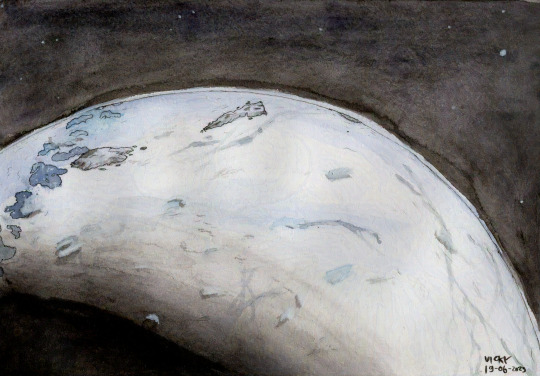
(1735's Snowball Earth, by me)
From 1704 to 1730, the entire planet froze over. After merely two years of thaw, it happened again, this time lasting from 1732 to 1742. But these snowball Earth episodes set the stage for the evolution of animals that began right after. Across the mid-18th century, the bizarre Ediacaran biota, with its strange symmetries, fronds, and fractal-like pattern filled the oceans. In the early 1780s they went extinct, possibly due to a temporary drop in oxygen-levels, only to be replaced by a great variety of quite different creatures in the Cambrian Explosion.
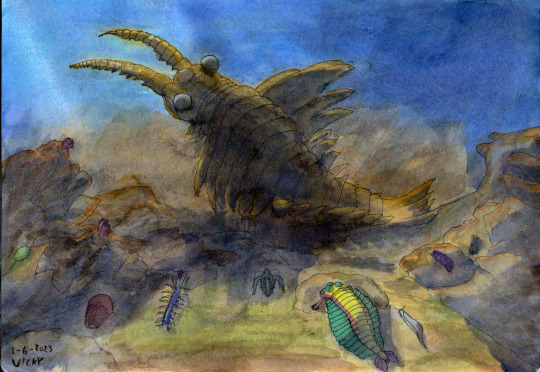
(Class of 1799, by me)
Starting in 1784 and running for a few decades, the Cambrian period saw the origin of most of the modern animal phyla, reaching its most famous form in the Burgess Shale fauna of 1799. During this time, most animals still lived on the sea floor, either attached or crawling, with relatively few actually swimming creatures. Plants started tentatively moving onto land around 1817, and in 1825, the rising of the great Appalachian mountains caused a severe drop in global CO2 and thus temperatures, leading to the Late Ordovician mass extinction.
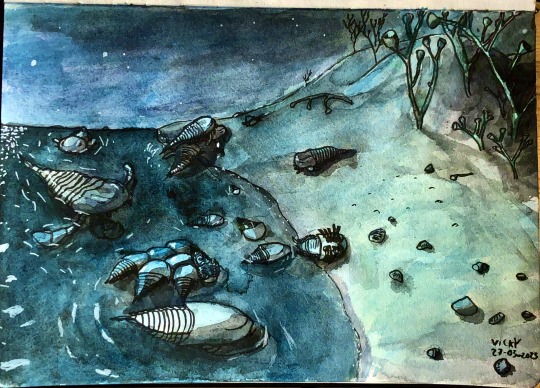
(Horseshoe crabs and sea scorpions on a beach in 1834, by me)
Bony fish first showed up during the 1830s, and around the same time plants were getting serious about inhabiting the land, evolving roots and vascular tissues so they could properly grow there. Millipedes and the ancestors of spiders were the first animals to follow them onto land. Our own fishy ancestors did not take their first step until 1857, by which point the arthropods were well established there and the plants had figured out how to become trees. The Late Devonian extinction, partially caused by the evolution of said trees and partially by the south pole freezing, played out in two pulses over the late 1850s and early 1860s.
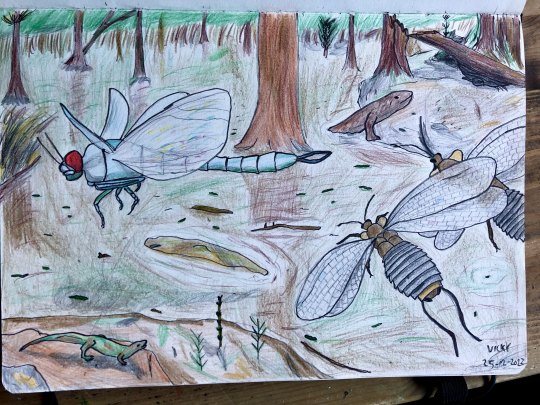
(Swamp prominently featuring Meganeura and Mazothairos in 1889, by me)
Arthropods and vertebrates continued to gain adaptations to life on land. The insects became the first creatures ever to fly in 1878, and the high-oxygen atmosphere of the time would be especially good to them. Around 1884, a group of vertebrates called the amniotes, after the membrane that kept water inside their eggs so they could lay them on land without them drying out, split into two groups: the reptiles and the synapsids (which we mammals descend from). The next few decades would see the synapsids in particular being extremely successful as the supercontinent Pangaea formed. Until 1912, when a massive episode of volcanism caused the worst mass extinction of all time, the Great Dying, scouring the Earth of a huge portion of its life.
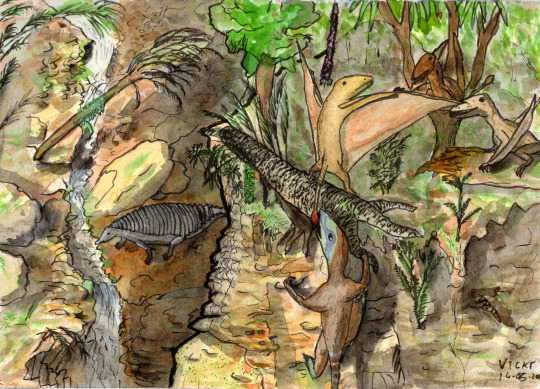
(A 1930 scene featuring the three branches of archosaur: dinosaur, pterosaur, and pseudosuchian, by me)
The 1910s were a period of slow recovery during which strange new forms of animal evolved. Many different, unrelated reptiles, such as the ichtyosaurs and plesiosaurs, went to sea, where they would continue to provide some of the most impressive creatures for most of the 20th century. On land, the dinosaurs first appeared in 1920, though for the next decade or so they'd live in the shadow of their pseudosuchian (crocodile-line) cousins. In 1934, Pangaea began to break up, resulting in another terrible pulse of volcanism that caused a lot of extinctions and left particularly the feathered and furry survivors with a lot of empty niches to fill, allowing the dinosaurs and mammals to diversify greatly. The last common ancestor of all modern mammals lived in the early 1940s, and by 1957 the dinosaurs had figured out flight, with Archaeopteryx usually being considered the first bird. Other dinosaurs took on an incredible variety of sizes, shapes, and forms. Some of the most famous ones include Dilophosaurus (1942), Diplodocus and Stegosaurus (1955), Iguanodon (1969), Velociraptor (1991), and Tyrannosaurus rex (1994).
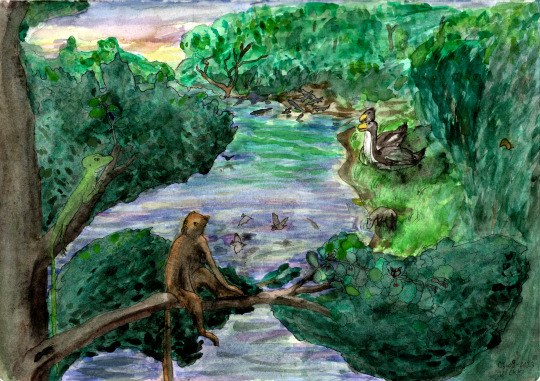
(A tropical lakeside in the year 2000, by me)
In 1995, the world was struck by a meteorite, wiping out many groups, including the marine reptiles, pterosaurs, and ammonites. The surviving mammals and dinosaurs went on to diversify across the next couple of years and had formed thriving new ecosystems in the tropical world of the turn of the millennium. The first known bat lived in 2001, and the whales returned to the oceans next year. Around 2009, the world's climates turned colder and dryer. Antarctica froze over and grasslands spread widely. Our last common ancestor with the chimpanzees and bonobos lived in 2021, and by new year 2023, our ancestors were getting brainier and more proficient with tools. That's also when the north pole froze and the Quaternary ice age cycle began. The first known members of Homo sapiens lived on 10 November 2023. The latest ice age started on 14 December, and ended at 2 AM on 30 December. The great pyramid of Giza was built at 6 AM on 31 December and On The Origin Of Species was published at 23:22 PM.
#palaeoblr#happy new year#2024#geologic timescale#vicky's vritings#one year is 2.244 million years if you're curious#and yes i did exclude both year 0 and 2024#since 0 doesn't exist and 2024 hasn't happened yet#my art#i rather enjoy having an extensive collection of my art to illustrate my paleorambles nowadays#incidentally the big bang occurred in 4121 bce at this scale#which is curiously close to the date of creation creationists made up#if only they would follow through and insist humanity itself was seven weeks old too
125 notes
·
View notes
Text
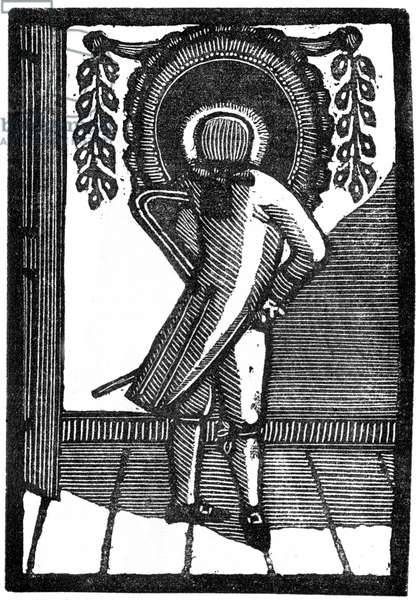
Francis Lewis was born in Yarmouth, MA in 1730 as Deborah Lewis. Later he and his family moved to Tisbury on Martha's Vineyard and he began living as a man in 1764. He married a young woman named Anne Luce in November 1765 and they had at least five children together!
An article in the 1770 edition of the Boston Evening-Post stated that because Lewis was born "bearing a similarity of both Sexes, it was disputed what apparel it should be dressed in, but 'twas at last agreed to dress it in Women's."
Here he is in a 1790 census from Tisbury:

Several notices were posted in New England newspapers upon his death.
In the Essex Register-January 22nd: "In Tisbury, (M. Vineyard) Mr Francis Lewis, aged 93—32 of which years he dressed as a woman, and was supposed to be such. After that, he took his proper apparel as a man, and passed the remainder of his life in the marriage state, and has left numerous descendants."
The Connecticut Courant -January 28th "At Tisbury, (M[assachusett]s.) Mr. Francis Lewis, aged 93—32 of which years he dressed as a woman, and was supposed to be such. After that, he took his proper apparel as a man, and passed the remainder of his life in the marriage state, and has left numerous descendants. The family has always deserved and received the respect of those who knew it."
261 notes
·
View notes